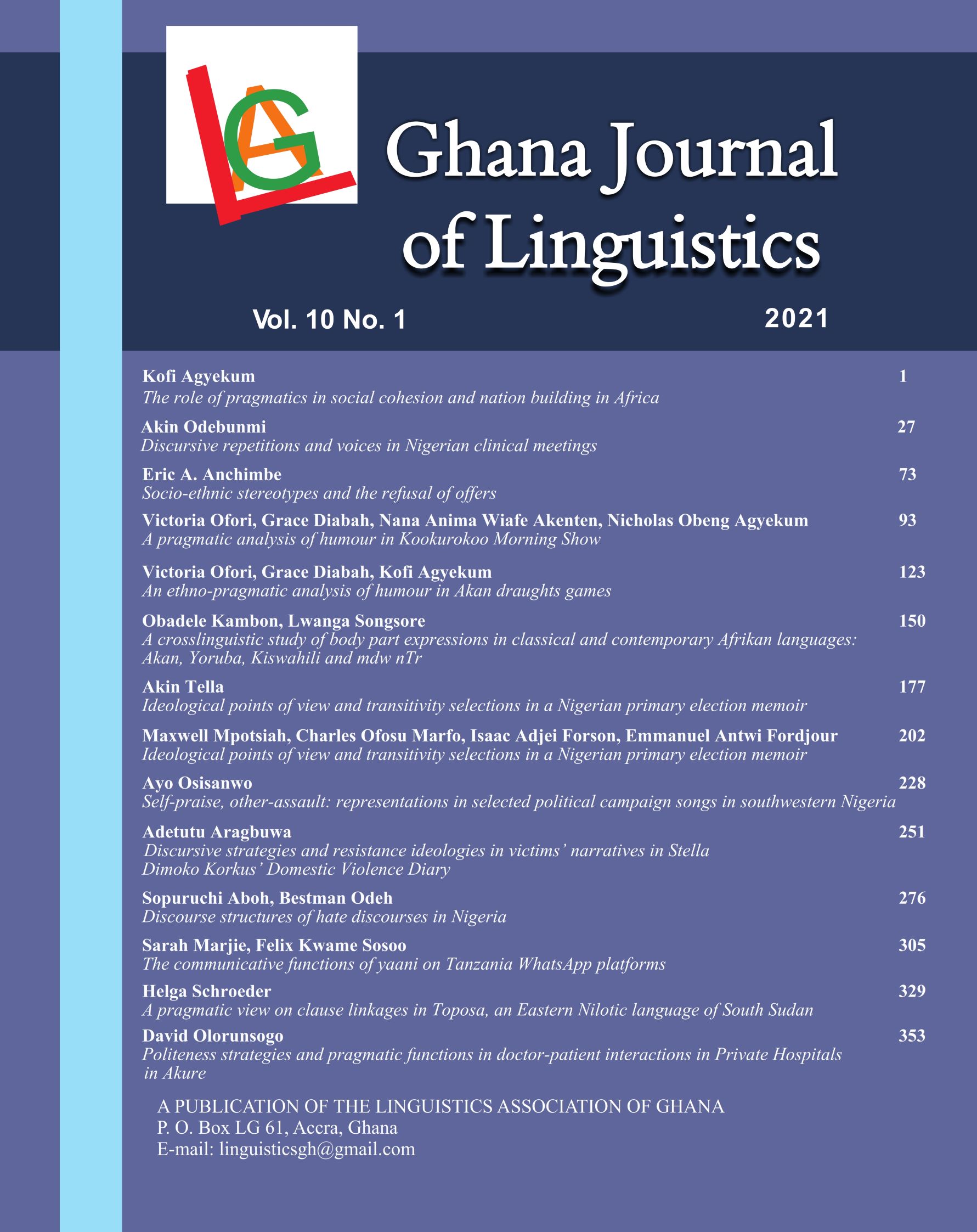Politeness strategies and pragmatic functions in selected doctor-patient interaction in Private Hospital in Akure
DOI:
https://doi.org/10.4314/gjl.v10i1.336Keywords:
Politeness, Hierarchy, Strategies, Medical discourse, Doctor-patient interactions, Private hospitalAbstract
This study examined how politeness strategies are constructed and their functions in doctor-patient interactions in Private hospitals in Akure. Although, polite behaviours have been investigated in the field of medical discourse with an emphasis on doctor-patient interaction, this study focuses on private hospitals, with an attempt to magnify the interplay of hierarchy between doctors and patients in private medical practice. Akio Yabuuchi's hierarchy politeness and Jacob Mey's pragmatic act theory were adopted to analyse the data for this study. Audio-taped recordings of doctor-patient interactions in private hospitals in Akure were selected for this study. Five strategies used by doctors are diagnostic elicitation, familiarisation elicitation, emotive pain-alleviation, consultation focusing, and lexical-substitution explanation. The patient-motivated strategy is complaint focusing. The pragmatic functions performed through these strategies are investigating, consoling, focusing, complaining, and inquiring. The negotiation of polite behaviours within social distance and power is evident in the data. Hierarchy in the interactions is relative depending on the type of existing relationship between doctor and patient. This relationship, in turn, determines the type of politeness used. Desires and their gratifications are also negotiated through the politeness strategies identified in the study.
References
Abdullahi-Idiagbon, Muhammed and AbdulRasaq Ajadi. 2014. “Pragmatics and social distance in doctor-patient and police-suspect conversation.” Journal of the Linguistic Association of Nigeria 17(1&2): 1-9.
Adegbite, Wale and Akin Odebunmi. 2006. “Discourse tact in doctor-patient interactions in English: an analysis of diagnosis in medical communication in Nigeria.” Nordic Journal of African Studies 15(4): 499-519.
Akerkar, Shashank and Lata Bichile. 2004. “Doctor patient relationship: changing dynamics in the information age.” J Postgrad Med 50(2): 120-122.
Ayeloja, Adewale and Taofeek Alabi. 2018. “Politeness and Discourse Functions in Doctor-Patient Verbal Interactions at the University College Hospital, Ibadan, Nigeria.” International Journal on Studies in English Language and Literature 6(12): 1-12.
Brown, Gillian and George Yule. 1983. Discourse analysis. Cambridge: Cambridge University Press.
Brown, Penelope and Stephen Levinson. 1987. Politeness: Some universals in language use. Cambridge: Cambridge University Press.
Černý, Miroslav. 2007. “On the Function of Speech Acts in Doctor-Patient Communication.” Linguistica ONLINE, 1-15.
Černý, Miroslav. 2010. “Interruptions and overlaps in doctor–patient communication revisited.” Linguistica ONLINE, 1-20.
Černý, Miroslav. 2010. “Questioning and responding practices in medical interviews revisited (Part I: Doctors).” Ostrava Journal of English Philology 2(1): 67-85.
Černý, Miroslav. 2010. “Questioning and responding practices in medical interviews revisited (Part II: Patients).” Ostrava Journal of English Philology 2(2): 31-42.
Iragiliati, Emalia. 2012. “Doctor-patient communication and preferred terms of address: respect and kinship system (a pragmatic study).” Makara Human Behaviour Study in Asia 16(1): 9-18.
Kaba, Riyaz and Prasanna Sooriakumaran. 2007. “The evolution of the doctor-patient relationship.” International Journal of Surgery 5: 57-65.
Kadhim, Basim. 2015. “Utterances of Husseini rituals: Situation-bound Pragmemes.” International Journal of Science and Research 6(3): 1220-1226.
Králová, Petra. 2012. “Power relations in doctor-patient Communication.” Bachelors diploma thesis, Masaryk University.
Mey, Jacob. 2001. Pragmatics. An Introduction. Oxford: Blackwell.
Odebunmi, Akin. 2013. “Greetings and politeness in doctor-client encounters in southwestern Nigeria.” Iranian Journal of Society, Culture and Language 1(1): 101-117.
Ohtaki, Sachiko, Toshio Ohtaki and Michael Fetters. 2003. “Doctor–patient communication: a comparison of the USA and Japan.” Family Practice 20(3): 276-282.
Olorunsogo, David. 2020. “Pilot study: Politeness strategies in selected doctor-patient interactions in Ibadan private hospitals.” International Journal of Research and Innovation in Social Science 4(8): 489-493.
Peterlicean, Andrea and Arina Modrea. 2010. “Negotiating meaning in technical discourse.” Scientific Bulletin of the “PetruMaior” University of TîrguMureş 7(2): 64-66.
Swafat, Suhair and Aseel Faiq. 2018. “Hedging in Doctor-Patient Communication: A Pragmatic Study.” Journal of Raparin University 5 (14): 57-74.
Unger, Jean-Pierre, Patricia Ghilbert and Pip Fisher. 2003. “Doctor-patient communication in developing countries.” BMJ 327: 450-450.
WHO. 2015. WHO global strategy on people-centred and integrated health services: Interim report. Geneva, Switzerland: World Health Organization.
WHO. 2016. Universal Health Coverage: Moving Towards Better Health - Action Framework for the Western Pacific Region. Geneva, Switzerland: World Health Organization.
Yabuuchi, Akio. 2006. “Hierarchy politeness: What Brown and Levinson refused to see.” Intercultural Pragmatics 3(3): 323-351.
Yanti, Aprili. 2018. “The professionalism of doctor through the language politeness: Pragmatics studies.” MELT Journal 3(2): 95-113.
Yule, George. 1996. Pragmatics. Oxford: Oxford University Press.
Zibande, Saye and Melek Pamukoglu. 2013. “‘Let’s examine your abdominal region:’ A conversation analytical study of doctor-patient communication.” Narrative and Language Studies 1(1): 1-12.

Downloads
Published
How to Cite
Issue
Section
License
Copyright (c) 2021 David Olorunsogo

This work is licensed under a Creative Commons Attribution 4.0 International License.
The Ghana Journal of Linguistics is published by the Linguistics Association of Ghana, P. O. Box LG 61, Legon, Accra, Ghana.
LAG Email: linguisticsgh@gmail.com. Website: http://www.laghana.org
GJL Email: gjl@laghana.org Website: http://www.laghana.org/gjl
© Linguistics Association of Ghana and individual authors, 2023.
